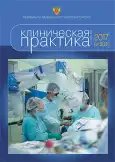НУТРИГЕНЕТИЧЕСКИЙ ТЕСТ В КЛИНИЧЕСКОЙ ПРАКТИКЕ: ЦЕЛИ И ВОЗМОЖНОСТИ
- Авторы: Зеленская Е.М.1, Кох Н.В.1, Слепухина А.А.1, Лифшиц Г.И.1
-
Учреждения:
- Институт химической биологии и фундаментальной медицины СО РАН
- Выпуск: Том 8, № 3 (2017)
- Страницы: 76-82
- Раздел: Статьи
- URL: https://journals.rcsi.science/clinpractice/article/view/8053
- DOI: https://doi.org/10.17816/clinpract8376-82
- ID: 8053
Цитировать
Полный текст
Аннотация
Ключевые слова
Полный текст
Открыть статью на сайте журналаОб авторах
Елена Михайловна Зеленская
Институт химической биологии и фундаментальной медицины СО РАН
Email: helenzlnsk@gmail.com
младший научный сотрудник ИХБФМ СО РАН 630090, г. Новосибирск, проспект Ак. Лаврентьева,8
Наталья Викторовна Кох
Институт химической биологии и фундаментальной медицины СО РАН
Email: natalikokh@gmail.com
научный сотрудник ИХБФМ СО РАН
Анастасия Александровна Слепухина
Институт химической биологии и фундаментальной медицины СО РАН
Email: creobrain@gmail.com
научный сотрудник ИХБФМ СО РАН
Галина Израилевна Лифшиц
Институт химической биологии и фундаментальной медицины СО РАН
Email: gl62@mail.ru
д.м.н.,профессор ИХБФМ СО РАН
Список литературы
- Hebebrand J, Volckmar A-L, Knoll N, Hinney A. Chipping away the “missing heritability”: GIANT steps forward in the molecular elucidation of obesity - but still lots to go. Obes Facts. 2010;3(5):294-303. doi: 10.1159/000321537.
- Speliotes EK, Willer CJ, Berndt SI, et al. Association analyses of 249,796 individuals reveal 18 new loci associated with body mass index. Nat Genet. 2010;42(11):937-948. doi: 10.1038/ng.686.
- Berná G, Oliveras-López MJ, Jurado-Ruíz E, et al. Nutrigenetics and nutrigenomics insights into diabetes etiopathogenesis. Nutrients. 2014;6(11):5338- 69. doi: 10.3390/nu6115338.
- Loos RJF, Yeo GSH. The bigger picture of FTO: the first GWAS-identified obesity gene. Nat Rev Endocrinol. 2014;10(1):51-61. doi:10.1038/ nrendo.2013.227.
- Xi B, Chandak GR, Shen Y, Wang Q, Zhou D. Association between Common Polymorphism near the MC4R Gene and Obesity Risk: A Systematic Review and Meta-Analysis. Mittal B, ed. PLoS One. 2012;7(9):e45731. doi: 10.1371/journal.pone.0045731.
- Johnson W, Ong KK, Elks C E, et al. Modification of genetic influences on adiposity between 36 and 63 years of age by physical activity and smoking in the 1946 British Birth Cohort Study. Nutr Diabetes. 2014; 4(9): e136. doi: 10.1038/nutd.2014.33.
- Mahmoudi T, Farahani H, Nobakht H, et al. Genetic Variations in Leptin and Leptin Receptor and Susceptibility to Colorectal Cancer and Obesity. Iran J Cancer Prev. 2016; 9(3): e7013. doi: 10.17795/ijcp-7013.
- Benton D, Young H A, A meta-analysis of the relationship between brain dopamine receptors and obesity: a matter of changes in behavior rather than food addiction? Int J Obes (Lond) 2016; 40: 12-21. doi: 10.1038/ijo.2016.9
- Киреева В.В., Кох Н.В., Лифшиц Г.И., Апарцин К.А. Дисфункция эндотелия как краеугольный камень сердечно-сосудистых событий: молекулярно- и фармакогенетические аспекты. Российский кардиологический журнал 2014; № 10 (114). С. 64-68
- Liu P, Yu D, Jin X, et al. The association between the FABP2 Ala54Thr variant and the risk of type 2 diabetes mellitus: a meta-analysis based on 11 case-control studies. Int J Clin Exp Med. 2015;8(4):5422-9.
- Smith CE, Tucker KL, Lai C-Q, et al. Apolipoprotein A5 and lipoprotein lipase interact to modulate anthropometric measures in Hispanics of Caribbean origin. Obesity (Silver Spring). 2010;18(2):327-32. doi: 10.1038/oby.2009.216.
- Cahua-Pablo J Á, Cruz M, Méndez-Palacios A, et al. Polymorphisms in the LPL and CETP Genes and Haplotype in the ESR1Gene Are Associated with Metabolic Syndrome in Women from Southwestern Mexico. Int J Mol Sci. 2015 Sep; 16(9): 21539-21554. doi: 10.3390/ijms160921539
- Palizban A, Rezaei M , Khanahmad H, and FazilatiM Transcription factor 7-like 2 polymorphism and context-specific risk of metabolic syndrome, type 2 diabetes, and dyslipidemia. J Res Med Sci. 2017; 22: 40. doi: 10.4103/1735-1995.202141
- Николаева А.А., Николаев К.Ю., Лифшиц Г.И. и др. Сосудистая реактивность при коронарном атеросклерозе и социально значимых факторах риска (курение и алкоголь): возможности её использования для профилактики, скрининга и лечения. Новосибирск: Изд. ГПНТБ СО РАН, 2011: 31(5): 48-52
- Say Y-H. The association of insertions/deletions (INDELs) andvariablenumbertandemrepeats(VNTRs) with obesity and its related traits and complications J Physiol Anthropol. 2017; 36: 25. doi: 10.1186/s40101-017-0142-x
- Zhang H, Wu J, Yu L. Association of Gln27Glu and Arg16Gly Polymorphisms in Beta2-Adrenergic Receptor Gene with Obesity Susceptibility: A Meta-Analysis. PLoS One. 2014; 9(6): e100489. doi: 10.1371/ journal.pone.0100489
- Saliba LF, Reis RS, Brownson RC, et al. Obesity-related gene ADRB2, ADRB3 and GHRL polymorphisms and the response to a weight loss diet intervention in adult women. Genet Mol Biol. 2014; 37(1): 15-22.
- Riedl I, Osler ME, Benziane B, et al. Association of the ACTN3 R557X polymorphism with glucose tolerance and gene expression of sarcomeric proteins in human skeletal muscle. Physiol Rep. 2015; 3(3): e12314. doi: 10.14814/phy2.12314
- Ravikanth VV, Rao GV, Govardhan B, et al. Polymorphisms in UGT1A1 Gene Predispose South Indians to Pigmentous Gallstones. J Clin Exp Hepatol. 2016; 6(3): 216-223. doi: 10.1016/j.jceh.2016.08.004
- Katsarou M-S, Latsi R, Papasavva M, et al. Population-based analysis of the frequency of HFE gene polymorphisms: Correlation with the susceptibility to develop hereditary hemochromatosis Mol Med Rep. 2016 Jul; 14(1): 630-636.
- Gong M, Long J, Liu Q, Deng HC. Association of the ADIPOQ rs17360539 and rs266729 polymorphisms with type 2 diabetes: A meta-analysis. Mol Cell Endocrinol. 2010;325(1):78-83. doi:10.1016/j. mce.2010.05.007
Дополнительные файлы






